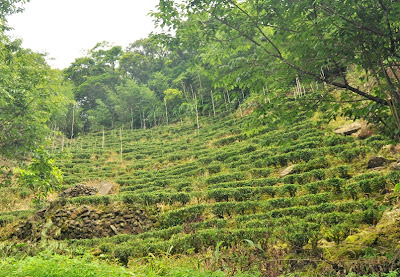I was lucky to discover such leaves during this spring's harvest in Pinglin! This was a surprise, because Tie Guan Yin is usually associated with Muzha, not with Pinglin. I think we have here the same process experienced by Baozhong in the last hundred 100 years: it started to be made in Nangang, very close to Taipei, and then the plantations gradually moved to Shiding and Pinglin. As the soils depleted and the city (pollution) grew, farmers found new land farther and farther from the capital.
Cultivar: Tie Guan Yin Oolong
Origin: Pinglin, Wenshan area
Harvested by hand on April 23rd, 2013
Process: low to medium oxidation, rolled, stems removed by machine and no roast
The dry leaves appear dark green. The brew's color is a strong and clear yellow. The leaves are more oxidized than Baozhong.
The fragrances are a mix of ripe apples, cinnamon and dark subtropical forest scents. It's very varied and rich.
The taste has a good mellow presence. It feels very rich, with a slight metallic/astringent taste, but no bitterness. Overall, a very pleasing and calm sweetness dominates on the palate. Such well oxidized Oolong also feels good on the stomach.
This Tie Guan Yin combines the character of its cultivar with the sweetness of the Wenshan area.
Tasting the following tea makes this tasting even more interesting:
These leaves come from the same harvest as those above (April 23rd, 2013). The difference is that they were roasted by a Tie Guan Yin farmer from Muzha. (The Pinglin farmer is used to roasting Baozhong, not Tie Guan Yin. He wanted to have an expert roast these leaves the proper way. The result provides him a guide of what he should aim for with his roast when he makes more TGY in the coming seasons.)
So, what we have here are leaves with a very traditional and rather strong roast. The result is very ripe fruity, powerful and even sweeter.
There are also dark smells of burned rubber. They are testimony of a strong roast. The relatively high oxidation of the unroasted Tie Guan Yin has made it less fragile and better suited for such a roasting.
But the wrinkled leaves open up and even return to a dark green color after several brews. This shows that the roast hasn't killed the freshness and liveliness of these leaves. This is the key difference with the 2008 strongly roasted Anxi Tie Guan Yin from my selection.
From comparing with the unroasted Tie Guan Yin above, we can experience how the roasting magnifies the aromas, ripens the fragrances and sweetens the taste. The immediate freshness seems lost, but we can still find it in the menthol mouthfeel of the aftertaste.
For an easier comparison, I have brewed both teas side by side:
 |
| Unroasted and roasted Pinglin Tie Guan Yin |
Enjoy your tea studies!















No comments:
Post a Comment